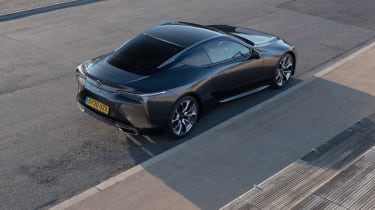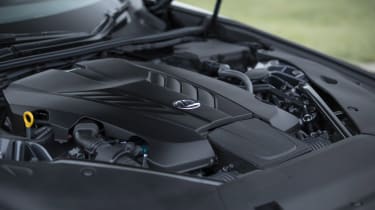Lexus LC500 Coupe review – engine, transmission and technical highlights
Two powertrains are available, both with ten-speed transmissions (of sorts). One is significantly better than the other.
As mentioned above, the LC Coupe is available in two distinct forms, each with a very different character. The more demure, sensible option is the LC500h, which as its name implies, is a hybrid. This is no Porsche Panamera Turbo S e-Hybrid-style powerhouse, rather a more laid-back combination of the Toyota group’s naturally aspirated 3.5-litre V6 engine and a small electric motor and lithium-ion battery pack. Instead of being able to run on pure electric as in a plug-in hybrid, the LC500h’s parallel system is more about engine assistance.
The transmission is equally unusual for the class, being a novel type of CVT gearbox. Rather than simply have a single belt-driven gearbox with infinite ratios, Lexus instead has a total of three CVT-like gears, each with three ‘steps’ within it to emulate the feeling of a short, sharp gearshift. There is then a top ‘fourth gear’ which brings the total to ten real and/or virtual gears. This gives an impression of shifting gears as the car accelerates that’s more akin to a normal automatic transmission.
The second engine and transmission combo is more familiar, pairing a naturally aspirated 5-litre V8 with a ten-speed torque-converter automatic gearbox. The engine is the same Yamaha-fettled unit found in the current Lexus RC-F, and it’s a wonderful, sonorous, charismatic unit that totally defines the LC.
The hybrid LC, although not inherently bad, is a calmer GT cruiser. When paired to this V8 though, the LC’s character totally changes. The auto’s shifts are short, sharp and, when in ‘Sports’ mode, decisive, but left to its own devices the gearbox can dither about – a complaint common with many transmissions with so many ratios to choose between.
For the 2021 model year, all LC500 models picked up a subtle set of front suspension upgrades including new forged lower wishbones, lighter coil springs and hollow anti-roll bars. Together, the new components remove 10kg of unsprung weight from the front axle and along with a thicker rear anti-roll bar and slight reduction in spring rate on those new springs, should make it feel pointier and more playful.





